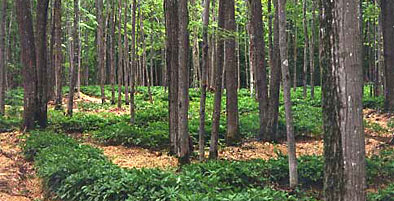Usually, yes. For many plants, slopes are not a problem. It is critical that when cultivating on steep slopes one does not contribute to soil loss or even potentially worse situations, such as landslides. As long as vegetation is currently on the slope, it is possible. Since it is often difficult to access and work on steep slopes, it depends on what plant(s) you are interested in growing and the access to the site.
The general term non-timber forest products embraces many different products. How can we categorize them?
Non-timber forest products are classified in many ways. One useful method organizes them into major product categories based on markets. In general, there are five major categories of products: edible and culinary, specialty wood, floral, medicinal and dietary supplements, and landscaping. The following sections provide information on some of the products within each category:
- Edible and Culinary: Edible and culinary products harvested from the forests include mushrooms, ferns, and the fruits, leaves, and roots of
What kinds of trees can be used for log cultivation of mushrooms?
The type of log or tree type to use for cultivation will depend on the type of mushroom you want to grow. Many mushrooms will grow on a variety of hardwoods, i.e., oaks or beech, but some are more specific about what species they will grow on than others. Also, keep in mind that some mushrooms prefer to grow on substrates (sawdust, straw, or composted manure) other than intact wood logs.
Can ostrich fern fiddleheads be forest farmed?
Ostrich fern fiddleheads, Matteuccia struthiopteris, are currently only harvested commercially from the wild, though much research has been done in New Brunswick, Canada, to be able to cultivate ostrich ferns commercially. Wild populations are sufficient at present to make cultivation of fiddleheads uneconomical. Ostrich fern occurs naturally across Canada to Alaska, and in the northcentral and northeastern United States to as far south as Missouri and Virginia. For more information on fiddleheads and their sustainable harvest, see: umaine.edu/publications/2540e/.…
Main Steps Involved in Forest Farming of Specialty Mushrooms

Biologically, forest cultivation of mushrooms involves fungal decay of an organic substrate, usually wood. The substrate is the “food source” for the fungus that allows the fungus to grow and eventually produce mushrooms. It is a rotten business to be sure. The process consists of four stages:
- Substrate Acquisition. For the most common forest-cultivated mushroom, shiitake, the substrate consists of wooden logs cut from live trees. The recommended size for logs is 3 to 4 feet long and 4
What is agroforestry? What is forest farming?
“Agroforestry” is a broader term for a variety of different land-use practices of which “forest farming” is one. Agroforestry includes a broad group of practices that integrate trees with annual crops and/or livestock on the same unit of land for environmental and economic benefits. Agroforestry practices are designed to meet individual landowner needs. Forest farming is one of five formally recognized agroforestry “practices” in the United States.
Agroforestry has been defined in slightly different ways by different organizations and individuals. …
What are some benefits of forest farming?
Forest farming can increase the economic value and utility of your forest and provide numerous environmental benefits, as well. If you are managing your forest for eventual timber harvest, forest farming can provide supplemental and more frequent income while you are waiting for the timber to mature. It is up to you as to how active you become in forest farming. You can simply manage wild populations of plants, fungi, and other natural resources that already exist in your forest …
Forest Farming and Non-Timber Forest Products Defined
Basics of Forest Farming
Forest Farming and Non-Timber Forest Products Defined

Forest farming involves the cultivation or management of understory crops within an established or developing forest. These systems represent integrated management of timber (which produces the canopy or overstory) and non-timber forest crops (which can be found below the canopy in the understory). The canopy of the forest is modified and maintained to provide the correct micro-conditions and protection for quality production of the understory or non-timber forest crops. …
Growing Food in Forests
Edible products can be farmed in forests. Ramps (Allium triciccum) and shiitake mushrooms (Lentinula edodes) are two prominent examples, but a wide variety of herbs and other edibles are also possible.

Ramps (Allium triciccum)
Spring is the time to harvest ramps, a popular forest vegetable in the eastern United States. This savory plant is a member of the onion family closely related to leeks. In early spring, ramps send up smooth, broad, lily-of-the-valley like leaves …
Where do I get seeds or cuttings to start forest farming?
This is an issue that may frustrate people interested in starting forest farming. You can check with local nurseries that sell native plants or that specialize in the types of plants you want to grow (herbs, medicinal plants, fruits). One great site for herbs is out of North Carolina — start with this one — (www.ces.ncsu.edu). You can also check the USDA National Agroforestry Center for information about forest farming and growing non-timber forest products at www.unl.edu/nac/agroforestrynotes. …
